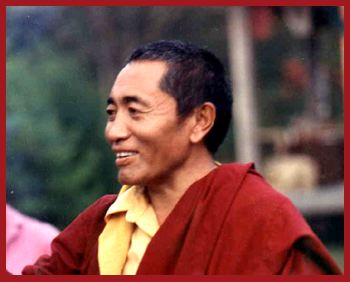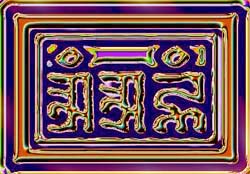"Guru Padmasambhava stayed in Tibet about 111 years. The book says he left for the West so maybe Guru Padmasambhava is here, somewhere in Tennessee."
-KPSR
12/6/87
______________________
means
"all phenomena are totally
pure
from the beginning"
According to our relative perception, our world is filled with errors, faults, stains and obscurations. We feel quite righteous about this. The faults of others, the imperfections of our environment, sometimes seem to be even more solid than tables and chairs. Our own flaws as well, if we are aware of them at all, sometimes can seem insurmountable or unforgiveable. But these, too, dissolve under close inspection and analysis. We cannot say that impurities exist anywhere, so how can we say we must become free of them? The idea of purity depends on the idea of impurity. Total purity from the beginning transcends such dualistic notions...
Because the absolute nature of reality is unchanging and incorruptible, it cannot be decreased or increased: it is unquantifiable. When we rest in the absolute nature, we are not expanding it in any way; when we begin to wander away from it, we are not shrinking it. The enlightened ones understood that absolute reality doesn't change under any circumstances, whether beings recognize it or not. Even Lord Buddha did not change the absolute nature in any way when he turned the Wheel of Dharma.
In the more elaborated Prajnaparamita teachings, it is often stated that this absolute nature, also known as buddha nature, is the inheritance of each and every sentient being. All of us, regardless of intelligence, character, or species, possess the buddha nature, and it is the buddha nature we seek to discover when we seek enlightenment. I say "discover" because it is not something essentially different from ourselves; we need not fabricate it or construct it on top of something else. When our buddha nature is revealed, we gain access to its many attributes, such as wisdom, compassion and loving-kindness. These qualities are extremely valuable. They guide us in times of delusion, and they radiate out to others in the form of communication, friendship, joy, and happiness. When relaxed and cheerful, sentient beings can actually share and work together.
If this absolute nature cannot be affected by increase or decrease, and all sentient beings possess it already, then why do we need to practice? It is often said that the buddha nature exists only as a potential, or spark, in the ordinary being; its brilliance is obscured by many layers of dualistic concepts, the bad mental habits of infinite lifetimes. Therefore it has always been necessary that we be clearly instructed in the truth of our relative existence. The many methods taught by the Buddha have the power to peel away our obscurations and allow us to see the truth for ourselves. Although these methods are many and varied, they all have as their essence the twofold mind-training of compassion and wisdom. Compassion and loving-kindness in themselves are undisputed as the greatest treasure of all sentient beings; even animals and insects are able to recognize their value. Compassion with the wisdom of emptiness together constitute the essential practices on the path to enlightenment - they are the great ornaments of the bodhisattva.
-from 'Ceaseless Echoes of Great
Silence,'
-Khenpo Palden's commentary on the
Heart Sutra (pp. 63-64) Sky Dancer Press, 1993
HOW
THE CYCLONE
CAME TO THE WEST
The Khenpo's father
The Teacher
The Venerable Lama Khenchen Palden Sherab Rinpoche was born on the eighth day of the fourth month of the Tibetan lunar calendar in 1941. The morning he was born, a light snow fell with flakes in the shape of lotus petals. Among his ancestors were many great scholars, practitioners and tertons. He was raised in the village of Joephu in the Dhoshul region of Khampa in eastern Tibet near the sacred mountain Jowo Zegyal. The family was semi-nomadic, living in the village during the winter and moving with the herds to high mountain pastures where they lived in yak hair tents during the summers. At seven he began studying at the monastery and started ngöndro practice. Later that year, he went on his first retreat for one month. At the age of twelve, he went to Riwoche monastery which was one of the oldest and larges monastic institutes in eastern Tibet. Here he was trained to be the next abbot at Gochen. He completed his studies just as the Chinese invasion of Tibet reached that area. In 1960 he and his family were forced into exile. They left in the middle of winter and were captured and escaped three times during the journey. His sisters died during the escape and his mother died shortly after reaching India. He and his father and younger brother lived in refugee camps until he was appointed to teach at Sanskrit University in Varanasi. He was also a founding member of the Institute for Tibetan Higher Studies where he was head of the department of Nyingma studies.
In his own words-
My own education began when I entered the great college at Do-Kham Riwoche Drukpa Khang... At first my behavior was wild, despite very strict rules. I was far away from home, and poor in supplies and clothing. I did not study, and failed the first examination. My teacher, the Khen Rinpoche, kindly and frequently offered his advice, but I did not listen until I was harshly criticized and punished by the Dharma disciplinarian. After that day, I recognized my faults. I began to listen and think without break, studying even at night by moonlight and, when the moon was gone, by the light of a burning stick of incense. Thus studying the great root and commentarial texts with care and diligence, I earned the praise of my teacher and the reputation of being the smartest among my peers. Khen Rinpoche poured over me all the teachings of the Victorious One, both the general and the particular, the holy treasures of the lineage masters, and the nectar-like instructions from the most secret long transmission of the Old Translation School. These latter included the teachings of the two omniscient ones, Rongzom and Longchenpa, and the pointing out instructions according to the texts of Jamgon Mipham. I, Palden Sherab, well attained all that.
When the Red Chinese barbarians came to destroy the Buddha's teachings and the culture of Tibet, I decided to leave. I gave away my every last possession, offered a communal tea, and, in front of Khen Rinpoche, offered a mandala as a prayer for his long life. On the night of my departure I went to see Rinpoche to offer a last white scarf. My heart was exceedingly sad. "Don't stay here," I pleaded, "please go to Padma Kö." "I won't be able to reach Padma Kö," he said. I pleaded again, but he replied in the same way. I continued to weep and plead, and he said, "Okay, okay, now don't cry. I'll pray that I'll be able to get to Padma Kö and India. No matter what karma you meet with, don't turn your mind away from the Three Precious Jewels. Now, you know that your learning is good. Therefore you will definitely benefit both teachings and beings. Don't mess up! Keep this in your mind."
It was 1961 when I
arrived in India. On the way, I had encountered great difficulties,
exhaustion and danger, but I always held his words closely in my mind. To
those Indian, Nepalese, Tibetan, and other people having faith in and
connections with me, I have taught whatever Tibetan Dharma and culture I
know. For seventeen years I taught in Varanasi at the Tibetan Institute
for Higher Studies where the number of good students÷through whom both
teachings and beings could benefit÷was not
small.
In 1980 Khenpo Palden made his
first trip to America.
In
1984 he moved to New York to work closely with H.H. Dudjom
Rinpoche.
In 1985
he founded Dharma Samudra Publishing to publish an eleven volume edition
of the termas
of Tsasum Lingpa in
Tibetan.
In 1988, he and
his brother, Khenpo Tsewang Dongyal
Rinpoche founded the Padmasambhava Buddhist Center.

KPSR
|
KPSR's commentary on Dakini Teachings KPSR's commentary on the Dudjom Tersar Ngöndro .. |
| Zhi-Khro
Teachings *
Karma Lingpa's Terma on the six bardos |
| The Eight Manifestations of
Guru
Rinpoche
*
KPSR on the many dimensions of the
Teacher |
| * these files |
TURTLEHILL ©
2001
![]()
